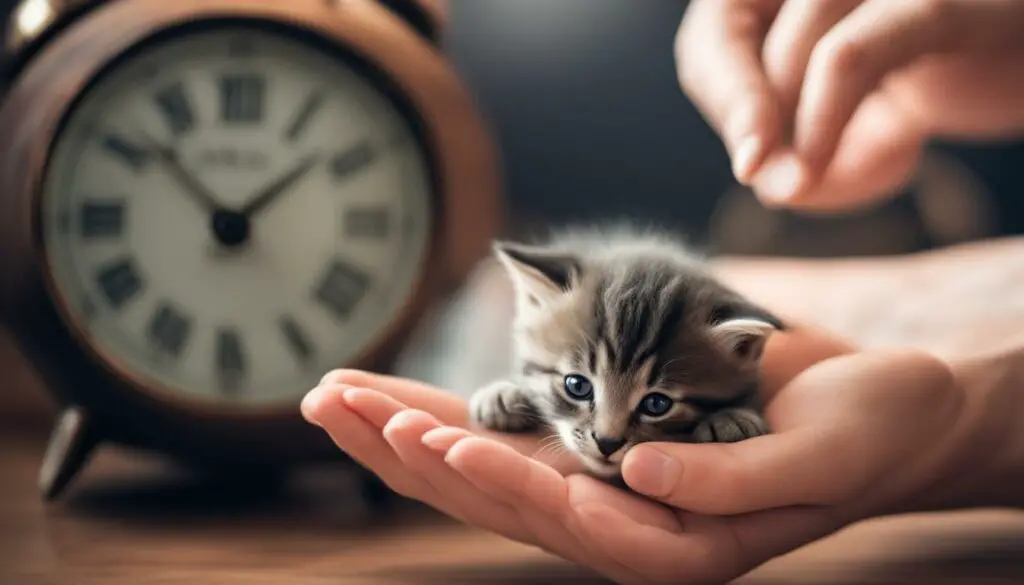Greetings! Today, I’ll be sharing some valuable tips on how to make a kitten poop. As a pet owner, I understand how important it is to ensure that our furry friends have regular bowel movements for their overall health and well-being. Whether you’re a new kitten owner or facing difficulties with a constipated kitten, this article will provide you with practical guidance to help your little one find relief.
But first, let me assure you that you’re not alone in this journey. Many pet owners have encountered similar challenges, and with the right approach, you can easily overcome them. So, let’s dive right in and explore the simple steps to make a kitten poop!
Key Takeaways:
- Position the kitten for stimulation by gently holding it and ensuring its rear is facing you.
- Use a warm wet washcloth or cotton balls to stimulate the kitten’s abdomen and anal region.
- Massage the anal area until the kitten poops or pees, ensuring cleanliness afterward.
- Be patient, as it may take some time for the kitten to poop.
- Regular veterinary check-ups will help monitor the kitten’s overall health and well-being.
Now that we’ve covered the key takeaways, let’s delve into each step in more detail. By following these simple techniques, you’ll be able to help your kitten maintain regular and healthy bowel movements. Remember, a happy and comfortable kitten is a joy to behold!
Tips for Stimulating a Kitten to Poop
If you find that your kitten is not pooping regularly, it’s important to know how to stimulate their bowel movements. By gently massaging the anal area with a warm wet washcloth or cotton balls, you can help trigger the kitten’s natural instinct to eliminate waste. This stimulation mimics the mother cat’s tongue bathing behavior, which encourages bowel movements in young kittens. Be patient during the process, as it may take some time for the kitten to poop.
If your kitten is still not pooping after feedings and stimulation, it’s advisable to contact a veterinarian for further guidance. They can assess the kitten’s overall health and provide recommendations on how to encourage regular bowel movements. It’s important to address any potential underlying issues and ensure the kitten’s well-being.
Remember, proper stimulation techniques and patience are key when trying to help a kitten poop. By providing the necessary care and attention, you can assist your kitten in maintaining a healthy digestive system.
For more information and tips, refer to the table below:
| Tip | Description |
|---|---|
| Use a warm wet washcloth or cotton balls | Gently massage the kitten’s anal area with a warm wet washcloth or cotton balls to stimulate bowel movements. |
| Be patient | It may take some time for the kitten to poop, so be patient during the stimulation process. |
| Consult a veterinarian | If the kitten is still not pooping after feedings and stimulation, contact a veterinarian for further guidance. |
Remember, every kitten is unique, and their bowel movement patterns may vary. If you have any concerns or questions about your kitten’s digestive health, it’s best to consult a veterinarian for professional advice.
The Importance of Hygiene After the Kitten Poops
After the kitten has finished pooping, it is essential to ensure proper hygiene to maintain its health and well-being. Cleaning and drying off the kitten’s bottom helps prevent rashes and infections. Use a dry towel or another clean washcloth to gently dry the area.
Poor hygiene can lead to discomfort and potential health issues for the kitten. Keeping the anal region clean and dry reduces the risk of bacterial growth and irritation. By maintaining good hygiene practices, you can support the kitten’s overall health and prevent any unnecessary complications.
Regular monitoring of the kitten’s poop is also important. If the kitten is not pooping regularly or experiences difficulties, it may indicate an underlying issue. In such cases, a change in diet or medical attention may be necessary to help the kitten pass stool more easily and prevent any discomfort.
Remember, cleanliness and hygiene are crucial aspects of caring for a kitten. By ensuring proper hygiene after the kitten poops and monitoring its bowel movements, you can contribute to its overall health and well-being.
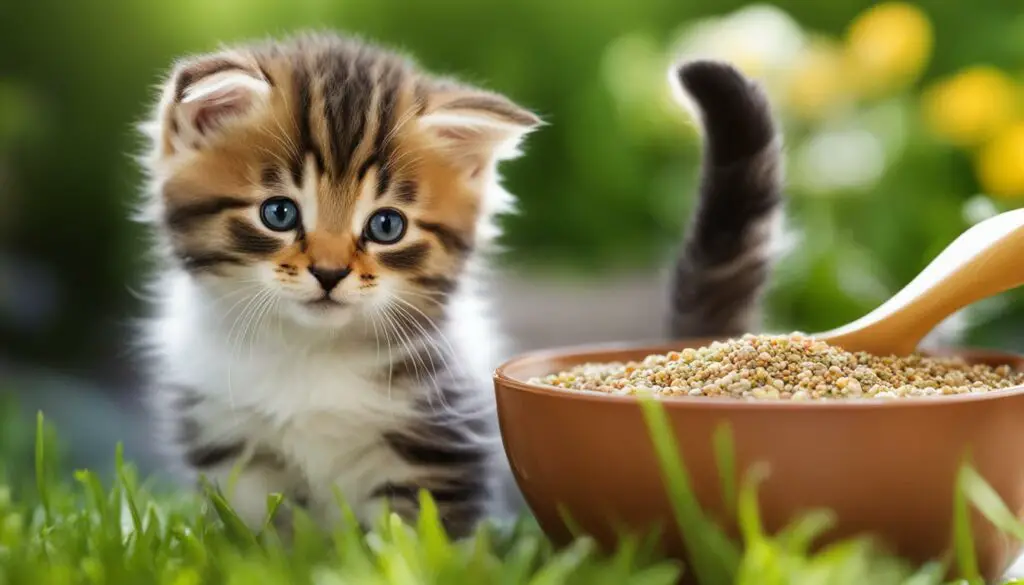
Choosing the Right Litter for Your Kitten
When it comes to litter selection for your kitten, it’s important to choose a product that is safe and efficient. Not all litters are suitable for young kittens, as some can pose health risks if ingested. Opt for clay or natural litters that are specifically labeled as safe for kittens. These types of litters are less likely to cause harm if accidentally swallowed.
In addition to choosing the right litter material, it’s essential to keep the litter box clean and accessible for your kitten. Regularly scoop out the waste and replace any soiled litter. This will not only ensure a fresh and pleasant environment for your kitten but also help to prevent any potential litter box aversions.
Kitten Diet and Regular Bowel Movements
Alongside the litter choice, providing a balanced diet for your kitten is crucial for regular bowel movements. Ensure that your kitten’s diet includes sufficient fiber, which can promote healthy digestion and prevent constipation. High-quality kitten food formulated with natural ingredients often provides the necessary fiber content to support regular bowel movements.
In some cases, a sudden change in diet can cause temporary digestive upset, leading to irregular bowel movements. If you’re transitioning your kitten to a new food, do so gradually over the course of a few days to minimize any digestive disturbances. If you have concerns about your kitten’s diet or bowel movements, it’s always best to consult with your veterinarian for guidance.
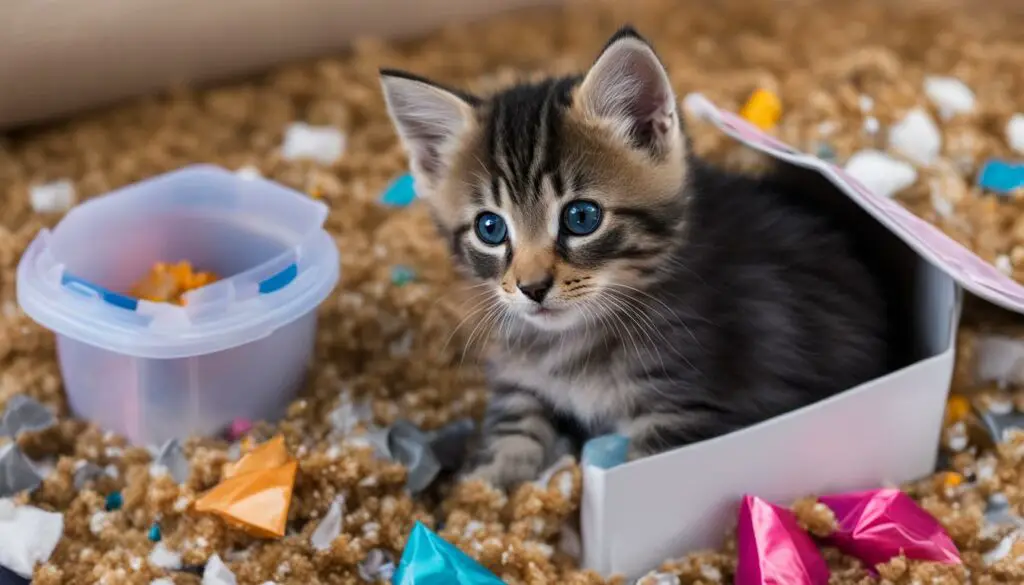
In conclusion, selecting the right litter for your kitten and maintaining a clean litter box, along with providing a balanced diet with sufficient fiber, are key factors in promoting regular bowel movements. By taking these steps, you can ensure the comfort and well-being of your kitten as they adjust to their new litter routine.
Create a Routine for Successful Litter Box Training
Establishing a routine is essential for successful litter box training and promoting your kitten’s digestive health. By following a consistent schedule, you can help your kitten develop good litter box habits and avoid constipation issues. Here are some tips to help you create an effective routine:
- Mealtime and litter box time: After each meal, place your kitten in the litter box. This will help them associate the litter box with the need to eliminate. Encourage your kitten to dig and scratch in the litter, providing a natural instinct to use the box.
- Naptime and litter box time: After your kitten wakes up from a nap, take them to the litter box. Kittens often need to eliminate after sleeping, so this is the perfect opportunity to reinforce good litter box behavior.
- Consistency and patience: Be consistent with the timing and location of the litter box. Avoid moving it around too frequently, as this can confuse your kitten. Patience is key, as it may take some time for your kitten to fully understand and adapt to the routine.
Remember to praise and reward your kitten every time they use the litter box correctly. Positive reinforcement will help reinforce good habits and create a positive association with the litter box. Consistency, patience, and positive reinforcement are the keys to successful litter box training.
| Litter Box Routine | Benefits |
|---|---|
| Place kitten in litter box after meals and naps | Associates litter box with elimination needs |
| Encourage digging and scratching in the litter | Stimulates natural instinct to use the box |
| Be consistent with timing and location of the litter box | Helps avoid confusion and promotes routine |
| Praise and reward kitten for correct litter box usage | Reinforces positive association with the litter box |
Dealing with Accidents and Clean-Up
Accidents may happen during the litter box training process. If the kitten has an accident, gently place them in the litter box immediately. Use an enzymatic cleaner to remove any traces of urine or feces from the accident site. This will help eliminate the odor and prevent the kitten from using that spot again.
Proper clean-up is crucial for maintaining a hygienic environment for your kitten. By promptly cleaning up accidents, you not only prevent the spread of germs but also reinforce the concept of using the litter box. It’s important to address accidents calmly and without scolding the kitten, as this can create anxiety and hinder their progress in litter box training.
Accident Clean-Up Checklist:
- Place the kitten in the litter box
- Use an enzymatic cleaner to remove odor and traces of urine or feces
- Thoroughly wipe the area with a damp cloth or paper towel
- Dispose of the soiled materials properly
- Apply a pet-safe disinfectant to sanitize the area
Remember to be patient and consistent with your litter box training efforts. Accidents are a natural part of the learning process, and it may take some time for your kitten to fully grasp the concept. By following these steps and providing gentle guidance, you can help your kitten become litter trained and prevent future accidents.

Monitoring Your Kitten’s Health and Development
Ensuring the health and development of your kitten is crucial for their overall well-being. By closely monitoring their digestive health and providing the right diet, you can help promote regular bowel movements. Regular veterinary check-ups are essential to address any concerns and ensure your kitten’s continued growth and health.
Importance of Regular Veterinary Check-ups
It is recommended to schedule a veterinary appointment within 24 hours of bringing your new kitten home. The veterinarian will conduct a thorough examination to assess their health, provide necessary vaccinations, and offer guidance on their diet and digestive health. Regular check-ups help monitor the development of your kitten and ensure any potential issues are addressed early on.
Choosing a Balanced Diet for Regular Bowel Movements
The diet you provide plays a significant role in your kitten’s digestive health and regular bowel movements. A balanced diet should include high-quality kitten food that meets their nutritional needs. Look for foods that contain sufficient fiber, as this can help regulate bowel movements. Consult with your veterinarian to determine the appropriate diet for your kitten’s age, breed, and specific needs.
| Dietary Tips for Promoting Digestive Health |
|---|
| Offer a combination of wet and dry food to provide hydration and fiber. |
| Ensure access to fresh water at all times. |
| Avoid feeding your kitten table scraps or foods that may upset their stomach. |
| Introduce new foods gradually to prevent digestive issues. |
| Monitor your kitten’s appetite and weight to ensure they are eating well. |
Observing Your Kitten’s Behavior and Stool
Being attentive to your kitten’s behavior and stool can provide valuable insights into their digestive health. Keep an eye on the frequency and consistency of their bowel movements. Diarrhea, constipation, or any changes in stool color or odor may indicate underlying issues that should be addressed with your veterinarian. Additionally, observe their eating habits, energy levels, and overall behavior to ensure they are thriving.
By monitoring your kitten’s health and development, providing a balanced diet, and seeking veterinary guidance when needed, you can help maintain their digestive health and ensure regular bowel movements.
Introducing the Litter Box to Young Kittens
If you have recently welcomed a young kitten into your home, it’s important to introduce them to the litter box as early as possible. Proper litter box training sets the foundation for good bathroom habits and helps prevent accidents in the future. Here are some simple steps to help you introduce the litter box to your young kittens:
Step 1: Choose the Right Litter Box
Start by selecting a litter box that is appropriate for the size of your kitten. A shallow litter box with low sides is ideal for young kittens, as it is easier for them to climb in and out. Place the litter box in a quiet and accessible area of your home, away from their sleeping and eating areas.
Step 2: Show Them the Litter Box
When your kittens are around 4 weeks old, gently place them in the litter box after each meal. Allow them to explore the litter and dig around. This will help them associate the litter box with the act of elimination.
Step 3: Encourage Natural Behavior
Encourage your kittens to engage in their natural digging and scratching behavior by placing a small amount of dirt or litter in the litter box. This will help them understand that the litter box is the appropriate place to relieve themselves.
Step 4: Be Patient and Consistent
It’s important to be patient and consistent during the litter box training process. Praise and reward your kittens when they use the litter box correctly, and clean up any accidents promptly with an enzymatic cleaner. With time and positive reinforcement, your kittens will learn to use the litter box consistently.
| Benefits of Litter Box Training | Common Mistakes to Avoid |
|---|---|
|
|
Remember, introducing the litter box to young kittens requires patience and consistency. By following these steps and providing a positive and clean environment, you can help your kittens develop excellent litter box habits that will last a lifetime.
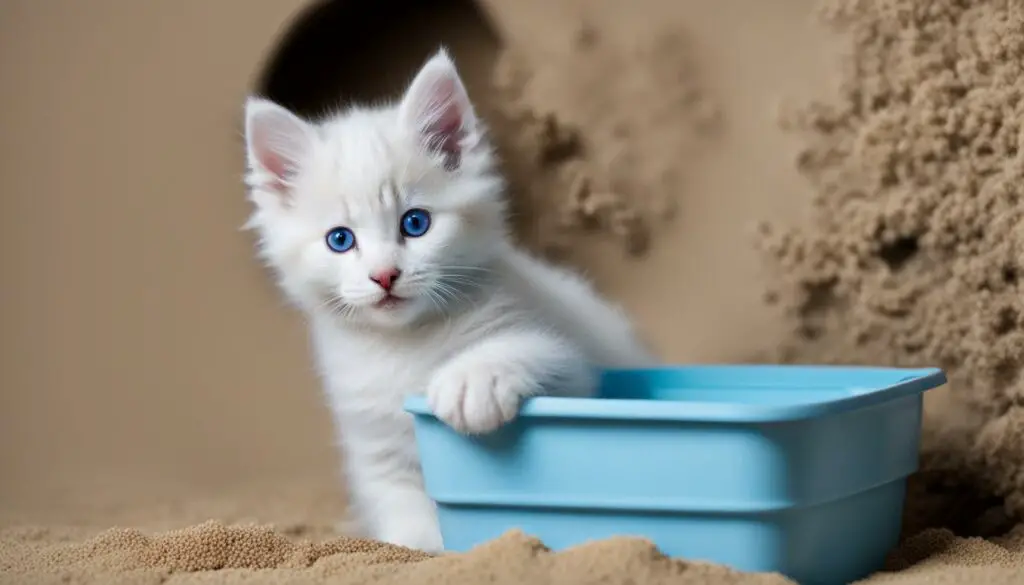
Preventing Common Mistakes in Litter Box Training
When it comes to litter box training, there are some common mistakes that can hinder your kitten’s progress. By avoiding these pitfalls, you can ensure a smoother training experience and help your kitten develop healthy bathroom habits.
1. Giving your kitten too much freedom
Allowing your kitten full access to the house before they are fully litter trained can lead to accidents and confusion. To prevent this, confine your kitten to a small, easily supervised area where you spend most of your time. This will allow you to closely monitor their litter box usage and prevent accidents from occurring in other areas of the house.
2. Failing to close off inaccessible areas
It’s important to close bedroom doors and barricade areas without doors to prevent your kitten from finding secluded spots to relieve themselves. By limiting their access to such areas, you can help guide them to the litter box consistently and reinforce the desired behavior.
3. Lack of patience and consistency
Successfully litter training a kitten takes time and consistency. It’s important to be patient and not get discouraged if your kitten has accidents or takes longer to catch on. Keep providing gentle guidance and positive reinforcement when they use the litter box correctly, and avoid punishment for accidents. With time and consistency, your kitten will develop the habit of using the litter box consistently.
Remember, every kitten is different, and it may take some trial and error to determine what works best for your furry friend. By avoiding these common mistakes and providing a positive and consistent training environment, you can help your kitten develop good litter box habits and prevent issues such as constipation or irregular bowel movements.
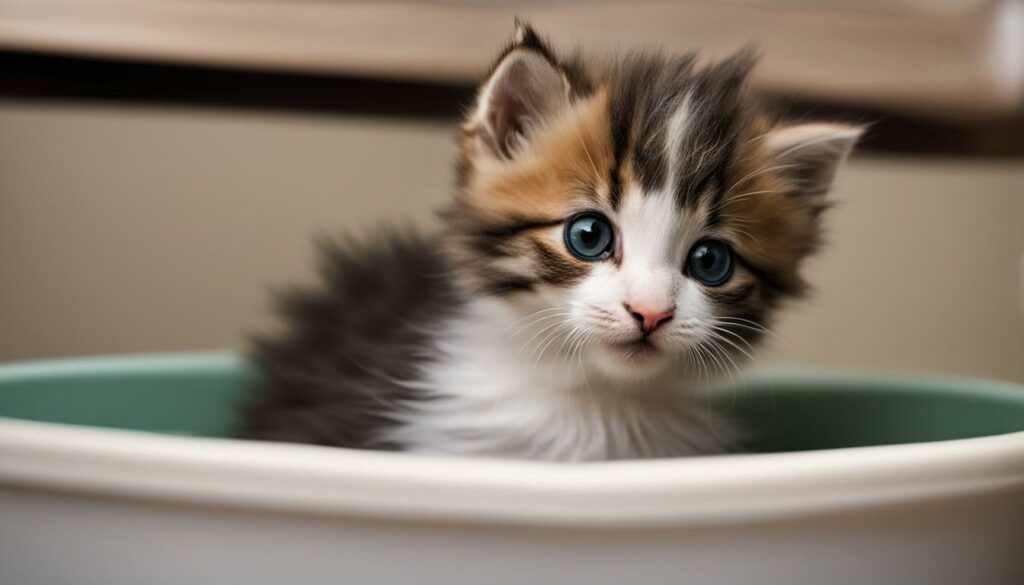
Additional Tips for Helping a Constipated Kitten
If your kitten is experiencing constipation, there are several remedies and techniques you can try to encourage regular bowel movements and promote their digestive health. Here are some additional tips:
- Increase water intake: Offer your kitten fresh water frequently throughout the day. You can also wet their dry kitten food to help increase their overall hydration.
- Add fiber to their diet: Incorporate foods rich in fiber, such as canned pumpkin or a small amount of plain yogurt, into your kitten’s diet. These can help soften the stool and alleviate constipation.
- Massage their belly: Gently massage your kitten’s belly in a circular motion to stimulate their digestive system and encourage bowel movements. Use a light touch and be careful not to apply too much pressure.
- Encourage exercise: Play and engage in physical activity with your kitten to encourage movement and help stimulate their digestive system. This can aid in relieving constipation.
If your kitten’s constipation persists or worsens despite these remedies, it is important to consult a veterinarian for further guidance. They can provide a thorough examination, offer additional treatment options, and ensure your kitten’s optimal digestive health.
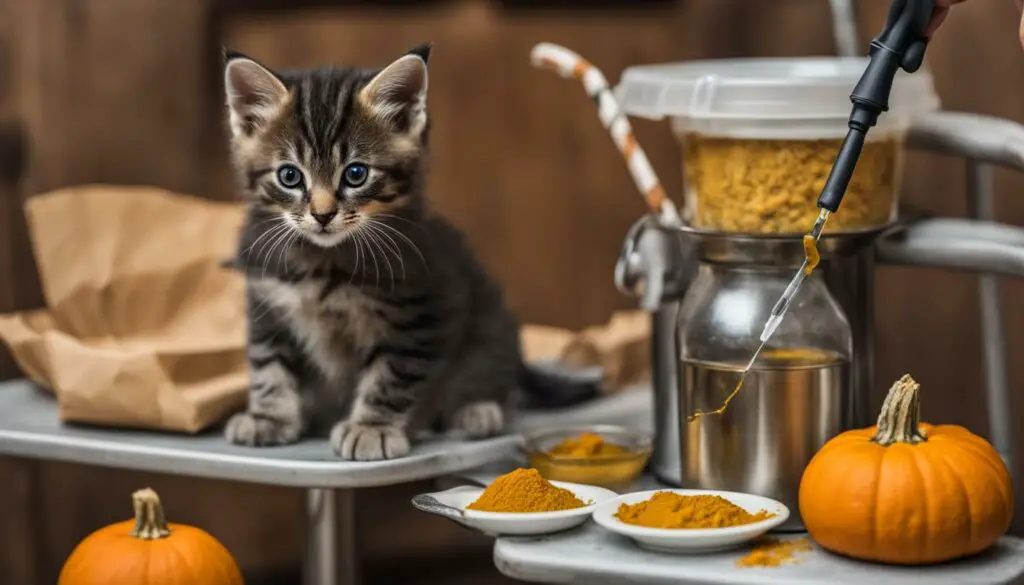
Possible Causes of Constipation in Kittens
Constipation in kittens can occur for various reasons. Some possible causes include:
- Dehydration: Insufficient water intake can lead to dehydration, which can result in constipation.
- Dietary factors: Inadequate fiber or a diet that lacks proper nutrients can contribute to constipation.
- Lack of exercise: A sedentary lifestyle with minimal physical activity can affect the digestive system and contribute to constipation.
- Medical conditions: Certain medical conditions, such as intestinal blockages or abnormalities, may cause constipation in kittens.
It is important to address constipation in kittens promptly to ensure their comfort and well-being. By implementing these additional tips and seeking veterinary advice when needed, you can help your kitten maintain regular bowel movements and optimal digestive health.
Importance of Proper Handling and Gentle Care
When it comes to stimulating a kitten to poop, proper handling and gentle care are of utmost importance. Rough handling can cause injuries or discomfort to the kitten, leading to a negative experience. As a caregiver, it’s crucial to find the right balance between a secure grip and a gentle touch.
When I stimulate a kitten to bowel movements, I start by positioning it correctly for stimulation. Gently hold the kitten with your non-dominant hand, ensuring that its rear is facing you. This position allows for easy access to the anal region and abdomen.
Using a warm wet washcloth or cotton balls, I gently massage the anal area to stimulate the kitten’s bowel movements. It’s important to be patient and allow the kitten time to respond. The stimulation mimics the mother cat’s tongue bathing behavior, providing a natural and comfortable experience for the kitten.
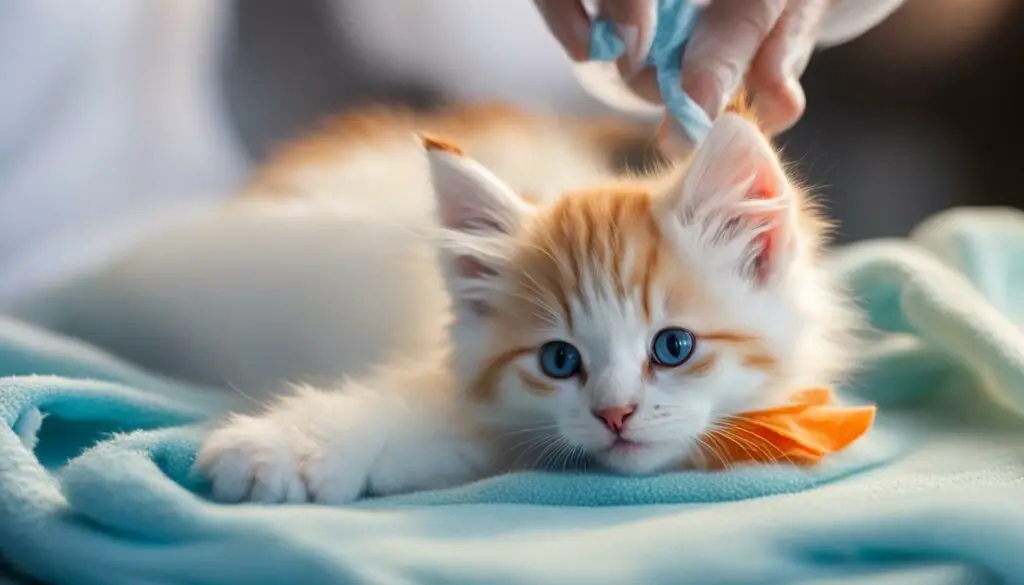
In addition to gentle handling, proper hygiene is crucial. After the kitten has finished pooping, it’s essential to clean and dry off its bottom to prevent any potential rash or infections. I use a dry towel or a clean washcloth to ensure the area is clean and dry.
By prioritizing the well-being and comfort of the kitten during the stimulation process, we can ensure a positive experience and promote regular bowel movements.
Maintaining Cleanliness and Hygiene
When it comes to taking care of a kitten, maintaining cleanliness and hygiene is essential for their health and well-being. By following proper practices, you can prevent the spread of infections and ensure a clean environment for your furry friend.
One important aspect of cleanliness is to clean the washcloth or any other materials used for stimulating the kitten’s bowel movements thoroughly after each use. This helps to eliminate any bacteria or germs that may have been transferred during the process. Additionally, it is crucial to dispose of soiled materials promptly to avoid the build-up of odors and prevent the spread of infections.
It is equally important to wash your hands thoroughly after handling the kitten. This ensures that any potential contamination is prevented, keeping both you and the kitten safe. By maintaining good hygiene practices, you can create a clean and healthy environment for your kitten to thrive in.
Importance of Cleanliness and Hygiene for Kitten Constipation
Cleanliness and hygiene play a significant role in managing kitten constipation. By keeping the litter box clean and accessible, you can encourage regular bowel movements in your kitten. Ensure that the litter box is changed frequently, removing any soiled litter promptly. This helps to prevent the build-up of waste, which can contribute to constipation.
In addition to keeping the litter box clean, it is important to provide your kitten with a balanced diet that promotes regular bowel movements. Consult with your veterinarian to determine the best diet for your kitten’s needs. Adding fiber to their diet can also help soften the stool, making it easier for them to pass. Be sure to provide plenty of fresh water to keep your kitten hydrated, which can also aid in maintaining regular bowel movements.
| Keeping the Litter Box Clean | Providing a Balanced Diet | Ensuring Hydration |
|---|---|---|
| Regularly remove soiled litter | Consult with a veterinarian for the best diet | Provide fresh water at all times |
| Keep the litter box easily accessible | Add fiber to the diet for softer stools | Monitor water intake to prevent dehydration |
| Promptly clean up any accidents | Offer wet kitten food for added hydration |
Maintaining cleanliness and hygiene is integral to managing kitten constipation. By following these practices, you can create an environment that promotes regular bowel movements and keeps your kitten healthy and comfortable.
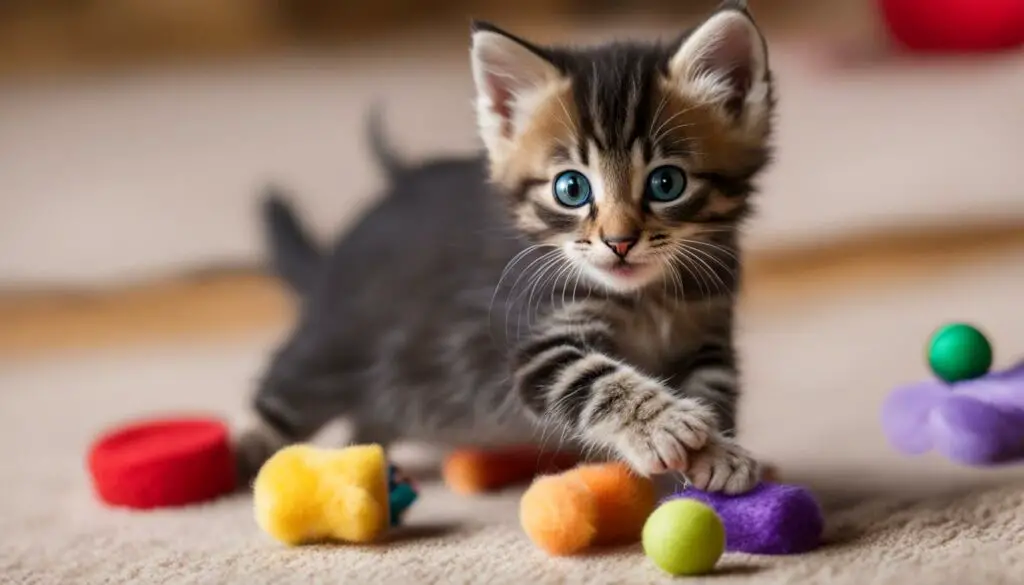
Conclusion
In conclusion, ensuring that your kitten has regular bowel movements is essential for its overall health and well-being. If you’re facing the issue of your kitten not pooping, there are remedies and steps you can take to help alleviate the problem.
First, establish a routine for your kitten by placing it in the litter box after meals and naps. Encourage exploration and provide positive reinforcement when your kitten uses the litter box correctly.
Additionally, maintaining proper hygiene is crucial. Clean and dry your kitten’s bottom after it finishes pooping to prevent rash or infection. Use safe litters and make sure the litter box is clean and easily accessible.
If your kitten is constipated, increase its water intake and add fiber to its diet. Massage its belly and encourage exercise to stimulate bowel movements. And if the issue persists, don’t hesitate to consult a veterinarian for further guidance.
FAQ
How do I stimulate a kitten to poop?
Position the kitten for stimulation by gently holding it with your non-dominant hand and ensuring its rear is facing you. Use a warm wet washcloth or cotton balls to stimulate the kitten’s abdomen and anal region. Massage the anal area until the kitten poops or pees. Adjust the washcloth to a clean spot and continue massaging as needed. Clean and dry off the kitten’s bottom after it has finished pooping.
What should I do if my kitten is not pooping?
If the kitten is still not pooping after feedings, contact a veterinarian for further guidance.
How do I maintain good hygiene after the kitten poops?
Clean and dry off the kitten’s bottom after it has finished pooping to prevent rash or infections. Use a dry towel or another clean washcloth to dry the area.
What type of litter should I choose for my kitten?
Select a litter that is safe for kittens, such as clay or natural litters. These litters are less likely to cause any harm if ingested by the kitten.
How can I successfully litter box train my kitten?
Establish a routine by placing the kitten in the litter box after meals and naps. Give the kitten time to explore the litter box and encourage them to dig and scratch in the litter. Praise and reward the kitten when they use the litter box correctly.
What should I do if my kitten has an accident outside the litter box?
If the kitten has an accident, gently place them in the litter box immediately. Use an enzymatic cleaner to remove any traces of urine or feces from the accident site.
When should I schedule a veterinary appointment for my new kitten?
Schedule a veterinary appointment within 24 hours of bringing a new kitten home. The vet will ensure the kitten is healthy and provide any necessary vaccinations or medications.
How do I introduce a young kitten to the litter box?
When kittens reach around 4 weeks old, introduce them to the litter box. Place the kitten in the litter box after feedings to help them understand its purpose.
How can I prevent common mistakes in litter box training?
Avoid giving your kitten full run of the house until they are fully litter trained. Keep them in a room where you spend most of your time to closely monitor their litter box usage.
What should I do if my kitten is constipated?
If your kitten is constipated, increase their water intake by offering fresh water and wet kitten food. Adding fiber to their diet can also help soften the stool. Massage the kitten’s belly and encourage exercise to stimulate bowel movements.
How should I handle the kitten during stimulation?
When stimulating the kitten to poop, be gentle and avoid applying too much pressure. Harsh handling can cause injuries or discomfort to the kitten.
How do I maintain cleanliness and hygiene during the process?
Clean the washcloth or any other materials used for stimulation thoroughly after each use. Dispose of soiled materials promptly to maintain cleanliness and prevent the spread of infections. Wash your hands thoroughly after handling the kitten to avoid any potential contamination.

